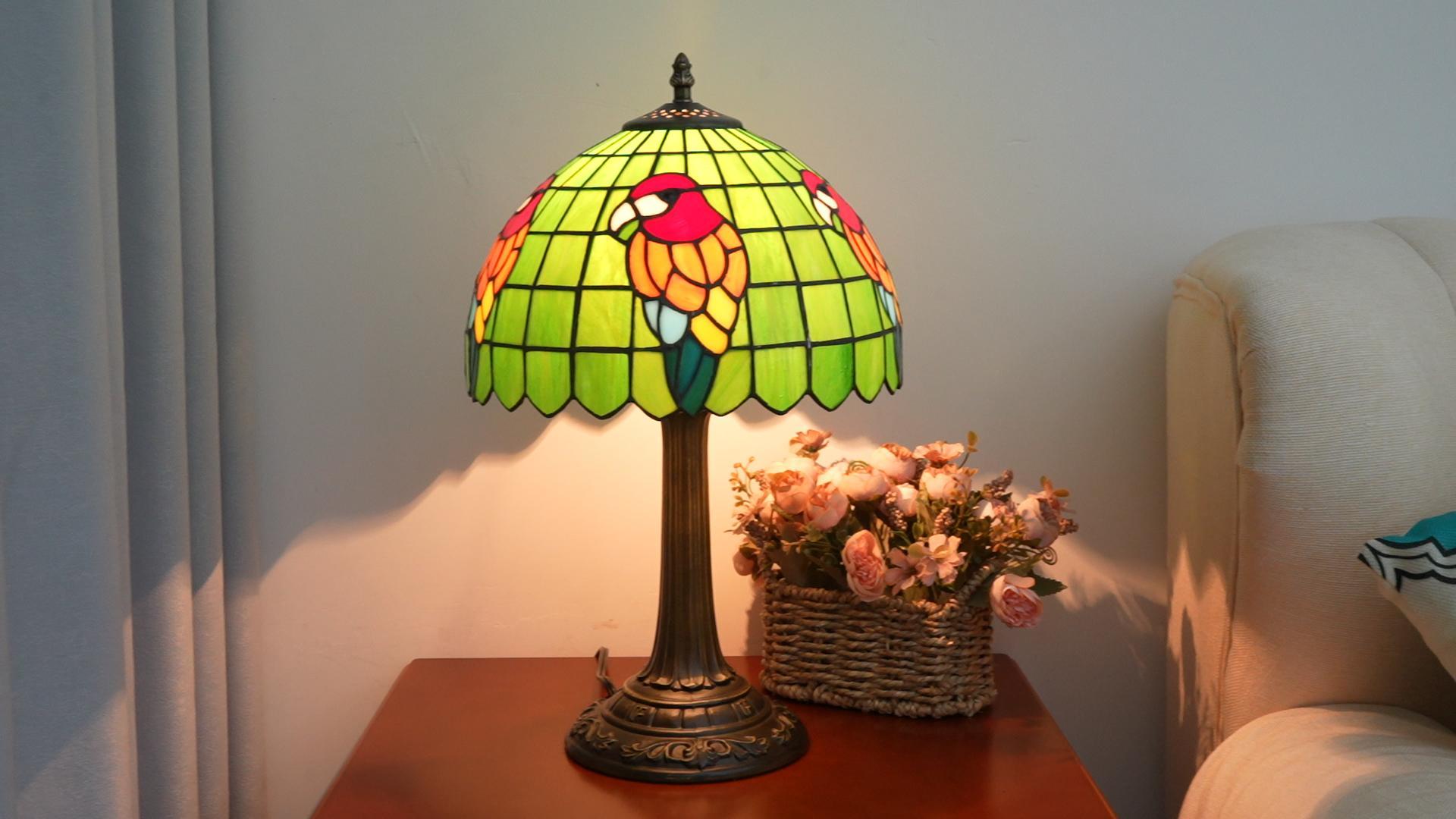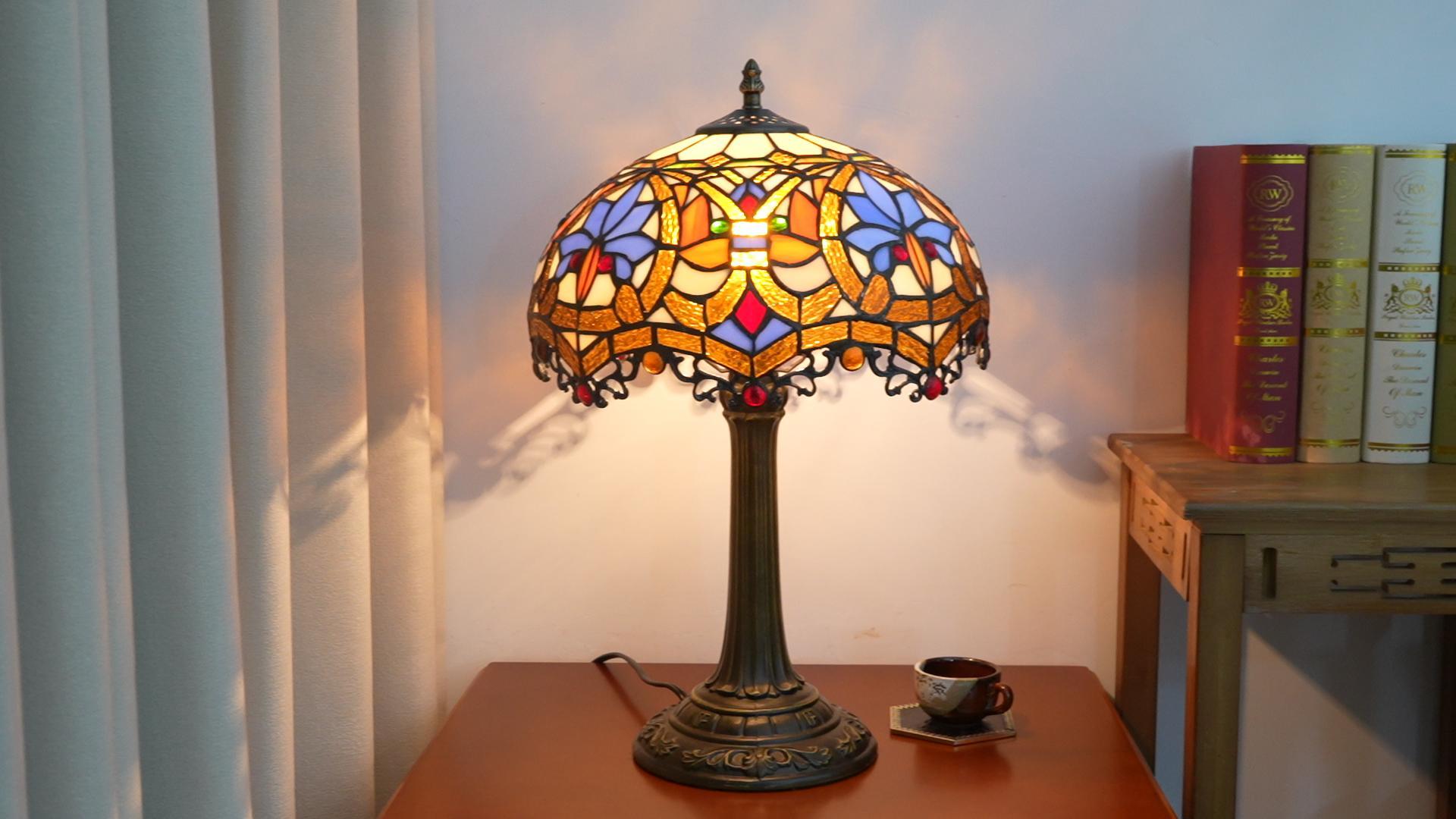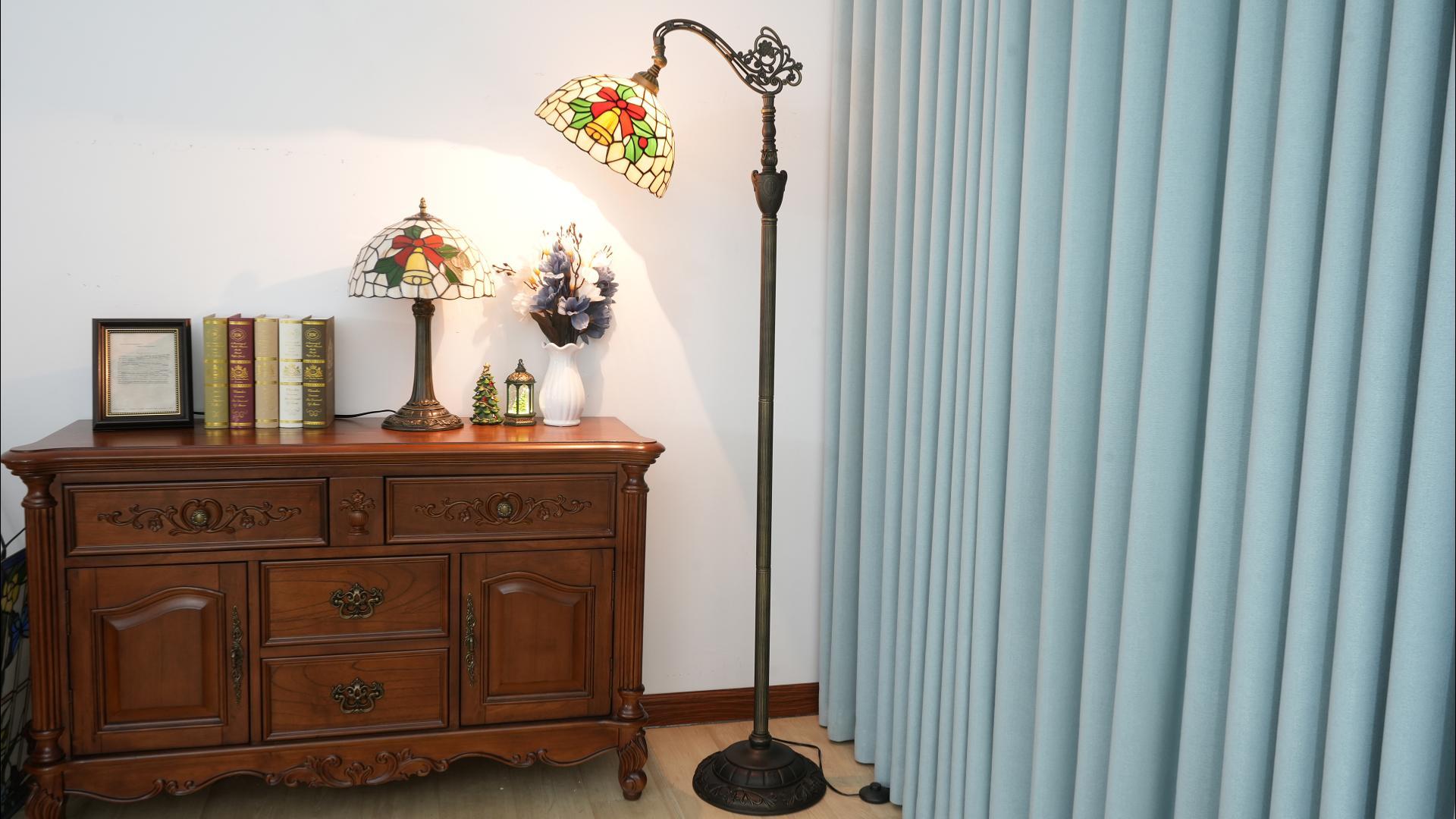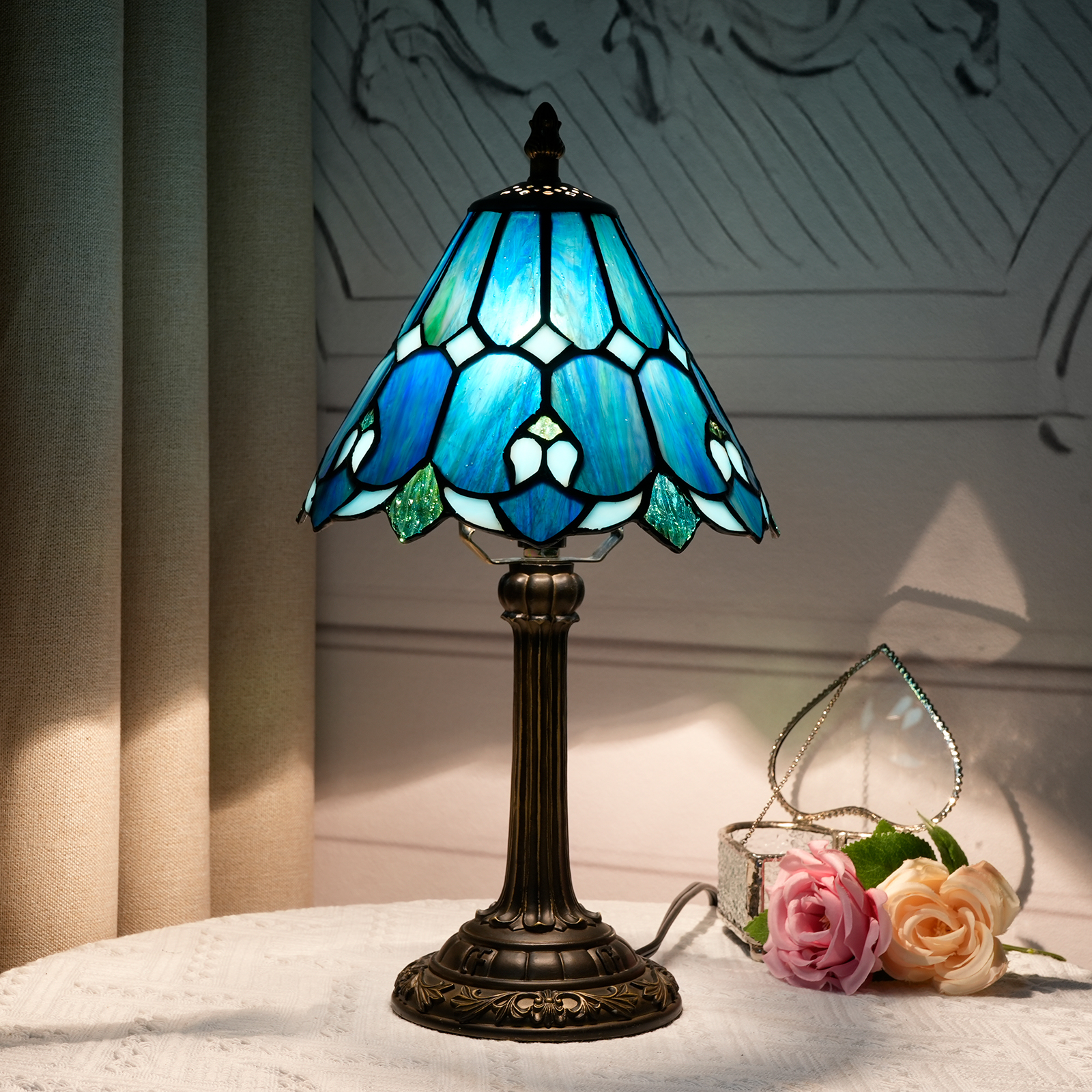Tiffany Vintage style yellow and white plaid stained glass Table lamp - light up the retro aesthetics, encounter the warmth of time
I. Brand Traceability: The Artistic Heritage of Tiffany
Tiffany, as a legendary symbol in the field of art glass and lighting, originated in the United States in the 19th century. At that time, the wave of the Industrial Revolution was sweeping through, but people were tired of the coldness of mechanical production. Tiffany, with handcrafted glass art as its anchor, went against the trend. The founder, Louis Comfort Tiffany, was deeply influenced by the Art Nouveau movement, obsessed with the integration of natural forms and colors, and regarded glass as a canvas carrying the magic of light and shadow. He broke through the traditional glass-making techniques and invented the unique "Favrile" glass, which gave the glass a texture and luster like natural gemstones, laying the foundation for Tiffany lighting's gene of "bringing nature into the interior and making light and shadow art". After a century, the Tiffany style has evolved from the high-end customization on Fifth Avenue in New York to the global home aesthetics space, becoming a classic symbol of the coexistence of retro and art. This yellow and white checkered colored glass table lamp is a brand-new chapter in the Tiffany heritage, continuing to write the warmth of retro.
Ii. Design Aesthetics: The Harmonious Blend of Retro and Nature
(1) Color Philosophy: A Time Filter Interwoven with yellow and White
Yellow and white are the main characters of this visual feast. Warm yellow, like the sunlight that spills into an old bookstore in the afternoon, carrying the warmth accumulated over the years, evokes people's tender memories of old movies and old letters. Pure white, like the window lattice covered with the first snow, neutralizing the heaviness of yellow and adding lightness and brightness. The two are interlaced in a grid pattern, not a simple color splicing, but a precise calculation about the retro atmosphere - the area and distribution of the yellow grids, after the designer's research on the psychology of light and shadow, ensure that when illuminated, the warm yellow can spread like ripples, enveloping the space. The white checkered pattern is like a breathing hole, preventing the light from being sticky or dazzling, creating a visual balance that is "retro yet not dull, warm yet not overly sweet".
(2) Tracing the Origin of the Form: Replicating the poetic framework of classics
The lamp body design of the desk lamp deeply replicates the retro genes of Tiffany. The outline of the lampshade inherits the curving aesthetics of the Art Nouveau period, with slightly undulating edges, resembling petals spreading out in nature, discarding the straight and cold hardness of modern industry. The lamp post is made of aged metal, with a dull bronze tone and fine texture. It seems to have stepped out of a 19th-century European antique shop, and every line tells a story of time. The solid curvature of the base not only ensures stability but also echoes the curve of the lampshade. The overall shape is like a gentleman in a vintage dress, standing gracefully, materializing the word "retro" from a style label into a tangible spatial sculpture.
(3) Glass Art: The Magic of Light and Shadow Inlaid by Hand
Colored glass is the soul of Tiffany table lamps, and this product takes the hand-inlaid technique to the extreme. Each piece of yellow and white glass has been carefully selected by artisans - the yellow glass needs to present an amber-like warm and lustrous color, while the white glass should be as soft and transparent as milk. When cutting, precisely cut according to the grid pattern. Millimeter-level errors are not allowed. During the inlaying process, the craftsman holds the slender copper foil, as if weaving the threads, piecing together the glass fragments into a complete pattern. The metallic luster of the copper foil is faintly visible in the gaps between the glass, adding layers to the light and shadow. When light penetrates the glass, it is not merely illumination but a "secondary creation of light" : the yellow glass filters out warm golden light, the white glass refracts a soft halo, and the grid pattern casts mottled patterns on the walls and tables, like the sacred light spots cast by the colorful Windows of an old church, or like the warm flickering lights in a retro cafe.
Iii. Process Analysis: The Journey of Craftsmanship from Raw Materials to Finished Products
(1) Glass selection: Nature's gift of colors
To restore the pure texture of the Tiffany style, the glass raw materials abandon the monotony of industrial mass production. Yellow glass is made with a formula containing natural minerals such as sulfur and iron. After high-temperature smelting, the mineral components form a unique flowing texture inside the glass. Each piece of yellow glass is a "unique natural fingerprint". The white glass is infused with bone China powder, endowing it with a milky white luster like jade, which is different from the dullness of ordinary white glass. The raw material screening process is like a "color archaeology". Artisans have to select the batch from hundreds or even thousands of pieces of glass that match the design in terms of color and texture, ensuring that the final yellow and white checkered pattern is a "perfect marriage of nature and art".
(2) Hand Inlay: An artistic practice within the millimeter
The inlaying technique is the "unique skill" of Tiffany table lamps, but it is also the most time-consuming and labor-intensive part. First of all, designers draw 1:1 scale pattern templates, just like precise architectural blueprints; The craftsman then places the cut glass pieces according to the position of the template. At this point, the splicing error of the glass pieces must be controlled within 0.5 millimeters; otherwise, the regularity of the overall pattern will be disrupted. Next, special tin-lead alloy solder is used to weld along the edge of the glass. The temperature and flow rate of the solder are controlled by the craftsman based on experience - if the temperature is too high, it will burn the glass. Unstable flow rate will lead to uneven thickness of the weld points. The inlaying of each desk lamp requires the craftsman to spend tens of hours and repeat hundreds of welding actions. This is not an assembly line operation, but a "slow art of weaving light and shadow with hands".
(3) Aging treatment: Replicate the gentle wrinkles of time
The aging process of the lamp body is the key to making the retro feel take root. The metal lamp post and base are first treated for rust prevention, and then chemically colored and hand-polished to create a mottled effect of natural oxidation. The blending of colorants is an art. It is necessary to simulate the traces of decades of erosion rather than simply being "dirty and old". When hand-polishing, the craftsman seems to be "removing makeup" from the metal, focusing on polishing the frequently touched edges and protruding parts to make the aged effect fit the "traces of daily use", ultimately presenting a retro texture that "remains elegant despite the passing of time", as if this desk lamp had quietly accompanied several generations in the old Shanghai villas and Parisian attics.
Four. Spatial Adaptation: Illuminating the Retro Warmth of Different scenarios
(1) A corner of the living room: The atmosphere of a retro salon
In the retro corner of the living room, when the leather sofa, the solid wood coffee table and the Tiffany table lamp meet, a "dialogue of time and space" thus begins. In the evening, when the desk lamp is lit, the warm yellow and white checkered light pours down, casting a gentle glow on the leather sofa and weakening the electronic coldness of the modern living room. With retro records and an old photo wall, this place is no longer an ordinary living space but a venue for a "private retro salon". When sharing old stories with friends, the light and shadow pass through the glass grids, casting dreamy patterns on the walls, infusing every conversation with an artistic touch and making it the warmest "emotional container" in the living room.
(2) bedside: A Gentle Prelude to the Sleep Ritual
In the bedroom, the desk lamp is an important participant in the bedtime ritual. The yellow and white checkered light of Tiffany is different from the full illumination of ceiling lamps. Instead, it is like a "moonlight sieve", gently enveloping the bedside area. When reading, the diffuse reflection of light through the glass evenly falls on the pages, neither dazzling nor tiring, making the reading of words a pleasure. Put down the book. The warm yellow and white interwoven halo is like a soft emotional filter, easing the stress of the day and helping you fall asleep in the retro warmth. Even your dreams might be tinged with the romantic color of an old movie.
(3) Study Desk: A light and shadow magnetic field that sparks inspiration
In the study, the Tiffany desk lamp is the "balance point between reason and sensibility". When you are faced with blank draft paper or complex reports, the light in the yellow and white grids not only provides sufficient illumination to keep your mind clear but also breaks the solemnity of the space with its retro aesthetics. The handcrafted texture on the glass and the aged feel of the metal become the visual focus, inspiring creative inspiration. When writing an article, it seems as if one can touch the creative atmosphere of the literati a hundred years ago through the light. When dealing with work, retro aesthetics can also relieve anxiety, allowing efficiency and poetry to coexist, and transforming the study from an "office space" into an "inspiration field".
V. Emotional Value: Time Companionship Beyond Illumination
This desk lamp has long transcended its physical attribute as a "lighting tool" and has become a "carrier of time and emotion". For retro enthusiasts, it is a tangible heritage of Tiffany art and an opportunity to fulfill the dream of bringing museum-level aesthetics home. For a family, it is a "light and shadow stage" where elders recount the past and younger generations listen to stories when three generations live under one roof, allowing family memories to flow in a glow. For those living alone, it is a "silent companion" in the dead of night. The warm yellow and white grid light is like an old friend who won't disturb, dispelling loneliness and bringing a sense of security gently wrapped by time.
As technology makes lighting increasingly convenient and cold, the Tiffany retro-style yellow and white checkered colored glass desk lamp, with handcrafted art as its boat and retro aesthetics as its sail, carries people to the "harbor of slow time". It is not only a lamp but also a touchable "manual of retro life", reminding us that in an era of pursuing efficiency, there are still some beauties that are worth savoring and quietly preserving with the warmth of handcrafting and the posture of art.






